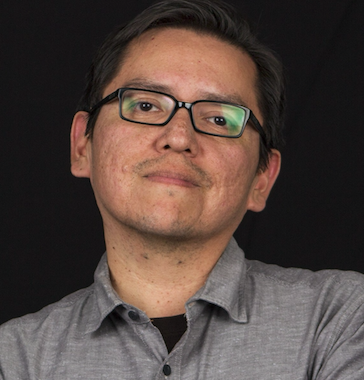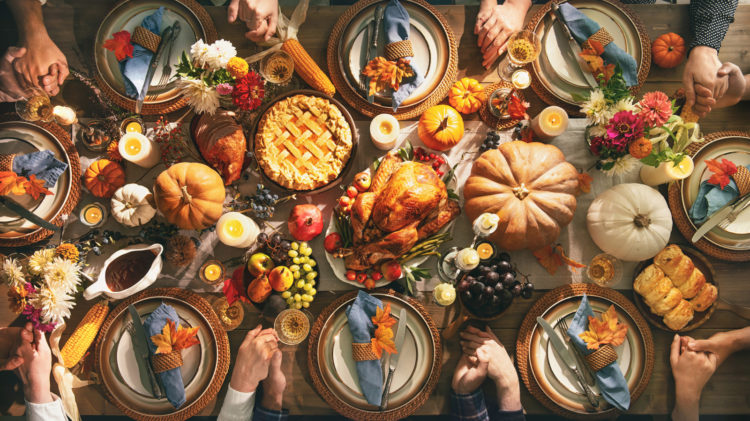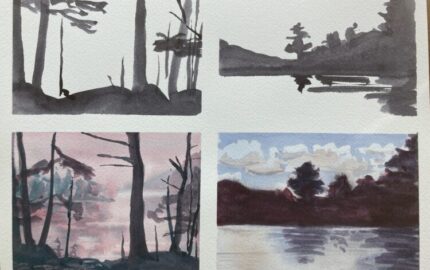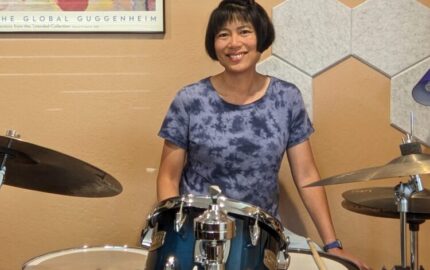EDITOR’S NOTE: From the archives, an essay by an Indigenous journalist, inspired by a story by another, about the myths of Thanksgiving and its white-bread centerpiece: turkey.
It happens enough in my life that I have become self-conscious when people ask if I celebrate Thanksgiving. I don’t mind the question. I only wish I had a more interesting answer.
Growing up, my grandparents spoke only Navajo. My parents are both bilingual; they still have to take a pause mid-conversation to recall how to translate some words or ideas from Navajo to English. My siblings and I were raised speaking English, a strategic choice my parents made with public school greatness in mind. Their hope, that we would eventually pick up the Navajo language, never quite made it to fruition.
With all this said, we celebrated Thanksgiving every year that I can remember. My parents would pack us into a pickup — the truck bed filled with food, paper goods and potable water — and we’d make the two-hour drive deep into the Navajo Nation. My grandparents lived in a single-room, cement hogan. An iron woodstove in the center kept it at a constant just-a-few-degrees-too-warm. There, our entire family would enjoy that traditional American meal, the only time of the year we ate turkey.
Turkey. We never mentioned “Thanksgiving” or talked about the history of the holiday. Yet we always ate turkey. I never questioned why. It was the meal the pilgrims ate when they invited the Indigenous people to the first Thanksgiving and that meant we all had to eat this giant, dry, bird every year.
“Turkey never tastes good,” agreed Washington Post reporter Dana Hedgpeth. “The meat is always dry. If it was that great we’d eat it all the time. I’ve never tasted a good turkey in my life.”

Earlier this month, Hedgpeth published a myth-busting piece exposing the myths that have formed about the origins of the holiday: “This tribe helped the Pilgrims survive for their first Thanksgiving. They still regret it 400 years later.” Her story, which ran Nov. 4, challenges the traditional understanding of Thanksgiving, in particular popular ideas like the pilgrims wearing those huge black, buckled hats and inviting the Wampanoag people — who, as the myths go, were adorned with the feathered headdresses — to enjoy a celebration of the bountiful harvest. According to her tenacious reporting, Hedgpeth found that it is unlikely that turkey was even featured at that first meal.
Actually, most of what has been taught throughout history about American Thanksgiving is false, and Hedgpeth made it her goal to challenge as many fictions as possible. Among the most surprising is that the pilgrims never actually invited the Wampanoag people to that harvest feast. That graceful invitation, shaped through history as a ‘thank you’ to the tribe’s people for helping the settlers survive the harsh new (to the settlers) land, never happened.
Instead, as Hedgpeth’s piece explains, tribal members arrived to the exclusive, celebratory event after hearing gunshots, likely fired in revelry:
At the sound of gunfire, the Wampanoags came running, fearing they were heading to war.
The tribe’s people decided to stay, but seeing that there was not enough food for the new guests (“The pilgrims aren’t really great at hunting at this point,” Hedgpeth told me.), Wampanoag hunters retrieved venison. The full menu that day likely consisted of several types of meat including quahogs, fish and shellfish — all foods plentiful in the Northeast at the time. Records show the meal also featured “fowl” — probably duck. Wild turkey was also plentiful, but Hedgpeth, who said she spent 10 hours researching Butterball, determined it is unlikely it made the menu. Even the English back then reportedly were not big fans of turkey, she said. “There’s so much better food,” Hedgpeth said. “Have venison stew, have rabbit, have shellfish.”

Even I am not sure why I, much like Hedgpeth was in her reporting, am obsessed with the turkey. Perhaps because it is the most iconic symbol of one of the most iconic American holidays. And as a Navajo, one of the more than 570 recognized tribes in the country, the story of Thanksgiving was distorted to me, my family and my second-grade class. That is when my class did the classic project: making Thanksgiving hats out of construction paper. I and most of the other Navajos in the class chose to make a paper headdress. At the time, I knew there were Navajo kids and non-Navajo kids, but did not yet really understand tribal identity. I do remember a sense of pride that tribal people played a major role in such a big holiday — one for which we got to do an art project on a Wednesday and then two days off of school!
And yeah, a Thanksgiving lunch. I remember distinctly, at the request of one of the non-Native students, that the entire class wore our new paper headwear to eat that turkey.
History undressed
Over time that second grader grew up and learned terms like appropriation, assimilation, genocide. It would become clear that American history is fraught with atrocity. But turkey at Thanksgiving always seemed so deliberate, despite its unlikely place at the first table. The Wampanoag people didn’t even wear feather headdresses, according to Hedgpeth’s piece. If they wore anything to that feast, it was the tribal roach, a headpiece made from porcupine hair that looks like a mohawk. A Wampanoag roach would have been an exponentially cooler art project.
The entire lesson of Thanksgiving, as taught in American schools, was manufactured, and done so with almost no effort. Therein lies the value of pieces like this. Hedgpeth, herself a member of the Haliwa-Saponi tribe from the North Carolina area, picked up where decades and decades of school curricula floundered. One of the hardest things to write in news is history. How do you sell a centuries-old story to an audience without sounding like a textbook? Hedgpeth wanted a story full of moments that would make the reader pause contemplatively with an “Oh!” moment. Specifically she wanted to bust myths about Thanksgiving and offer unknown information about a national tradition most of us were taught in grade school.
Long marginalized and misrepresented in the American story, the Wampanoags are braced for what’s coming this month as the country marks the 400th anniversary of the first Thanksgiving between the Pilgrims and Indians.
But the actual history of what happened in 1621 bears little resemblance to what most Americans are taught in grade school, historians say.
***
For the Wampanoags and many other American Indians, the fourth Thursday in November is considered a day of mourning, not a day of celebration.
Because while the Wampanoags did help the Pilgrims survive, their support was followed by years of a slow, unfolding genocide of their people and the taking of their land.
Bringing history to now
Being a Native American in a non-Native newsroom can get confusing. You want to be a great journalist. You want to offer your perspective but not be pigeonholed as “the Native.” Hedgpeth, who has worked for The Post since 1999 and currently covers breaking news, tries to squeeze in one story a month about tribal issues. “Some people don’t want to be pegged like, ‘I’m Native American so therefore I should cover the Native American beat,’” Hedgpeth says. “Other people are fine with that. I think I have a sweet spot. I like what I do.”
In her story, Hedgpeth cites previous journalists and historians who probed the origins of the American holiday. She also credits her editors, who encourage her to write and question her stories, asking for more detail when needed and reigning in the narrative when it’s not. This helps reporters find a balance in how to belong and contribute to a newsroom without coming across as overbearing. Hedgpeth refers to a specific, non-Native editor, Lynda Robinson. “She’s very conscious of what she does and doesn’t know, and she’s never afraid to ask,” Hedgpeth said. “If she’s unsure, she never hesitates to make you go back to your subjects and say we need more to understand what this is about.” I have worked with non-Native editors who, lacking knowledge of the Native American experience, would give me almost free-reign — or no reign — to write about tribal issues. That only sowed self-doubt and over-analysis as I struggled to find that balance.
Hedgpeth is married to a non-Native. They are raising their kids in the D.C. area. When it comes to her family traditions, she is thoughtful and deliberate in both talk and action. Her children are aware of their heritage and their history. That includes this holiday, which a lot of Indigenous people see as a day marking the beginning of genocide. But Hedgpeth prefers to focus on Mother Bear, a Wampanoag elder who became the focal point of her Thanksgiving piece. She introduces her by placing her in a “modest, clapboard museum” a few miles from Plymouth, Massachusetts.
Inside the three-room house sits Mother Bear, a 71-year-old Mashpee Wampanoag, hand-stitching a deer skin hat. She’s lived her whole life in this town and is considered one of the keepers of the Wampanoag version of the first Thanksgiving and how the encounter turned into a centuries-long disaster for the Mashpee, who now number about 2,800.
She returns to Mother Bear a bit later in the piece:
Mother Bear, a clan mother … whose English name is Anita Peters, tells visitors to the tribe’s museum that a 1789 Massachusetts law made it illegal and “punishable by death” to teach a Mashpee Wampanoag Indian to read or write.
She recounts how the English pushed the Wampanoag off their land and forced many to convert to Christianity.
“We had a pray-or-die policy at one point here among our people,” Mother Bear said. “If you didn’t become a Christian, you had to run away or be killed.”
But it wasn’t bitterness that Hedgpeth drew on when we talked: “I think Mother Bear says it best: ‘Every day your feet hit the floor is the day to be thankful to the Creator.’ My two arms, two legs, two eyes. I am blessed, blessed, blessed to have these things able to move. Every day should be a day of Thanksgiving of sorts.”
For myself, when people ask if I celebrate the holiday, from now on, I’ll think about being a kid on the Navajo reservation. Before dinner, my grandfather would pray in Navajo, a prayer that my mom would say loved all of our family no longer with us, and protected those who still were. And much like the Wampanoags would tell Hedgpeth about how they come to terms with American history, I will keep in mind that it’s being with family — not the holiday —that is the real reason to celebrate.
“As many Wampanoags in my story say, today is about reflecting and being thankful,” Hedgpeth said. “Not for that first Thanksgiving, not for the slow years of genocide that happened to Native Americans. But be thankful that we survived and that we persevered and we’re still here.”
***
Jason Begay is an associate professor at the University of Montana School of Journalism where he teaches the Montana Native News Project. He grew up on the Navajo Nation and has worked as a reporter at the Navajo Times, The New York Times, the Oregonian and the Oakland Tribune.



